A. When it is shown in a pornographic magazine, film or website.
B. Never.
C. When it is emailed to government officials urging action to improve public health.
One could argue about A and B but this blog is [...]]]>
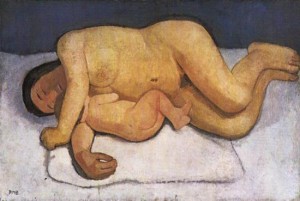
By Paula Modersohn Becker
When is a photo of a woman giving birth considered pornographic? Take your pick:
A. When it is shown in a pornographic magazine, film or website.
B. Never.
C. When it is emailed to government officials urging action to improve public health.
One could argue about A and B but this blog is about C.
Earlier this year, in Zambia, Chansa Kabwela, news editor at the feisty opposition newspaper The Post, was charged with circulating pornography with intent to corrupt public morals. What was her crime? During a nationwide strike by Zambia’s miserably paid doctors, a woman allegedly gave birth without medical assistance in a hospital car park. The baby was in a breech position and later died.
Her family sent Kabwela the photos but she found them too graphic for publication. Instead, she emailed them to the vice-president and other government officials and women’s groups, urging a negotiated end to the strike to avoid more deaths.
President Rupiyah Banda found the photos “morbid and peculiar” and Kabwela, a 29-year-old mother of two, was charged with the porn offence, which carries a five-year jail sentence. The state argued that giving birth is sacred in Zambia and the photos were disrespectful.
If giving birth is so sacred, why was the woman delivering in a car park?
Good sense prevailed and in November a judge acquitted Kabwela.
The Post has long been harassed by government for exposing corruption. This court case is one more instance, using birth, women and tradition as a cover to erode press freedom.
A very famous Christmas birth
This being the season of a famous birth, on the other side of the world, in New Zealand, a mischievous billboard about the immaculate conception has angered Catholics. 
It shows Joseph and Mary in bed. She looks blissful; he looks dejected. The kicker: “Poor Joseph. God is a hard act to follow.”
The twist is that the originator is an Anglican archdeacon who commissioned an ad agency to produce a Christmas poster. The archdeacon argues, somewhat confusedly, that the purpose was to highlight that Christmas is about love, not about Mary’s impregnation by God.
Within hours the billboard was defaced with brown paint. Well, at least this is better than rioting over caricatures of the Prophet or charging an editor with pornography.
Giving birth is charged with cultural meaning: it can be sacred, pornographic, joyful, “eculiar” or offensive. For half a million women, every year, it is deadly.
Yet these deaths do not spark the same outrage as a billboard or photographs.
My wish this Christmas is quite simple: safe delivery for women everywhere, not in a car park and not in a manger, neither holy nor unholy, whether through sex, artificial insemination or immaculate conception. Just safe.
***
Read about why maternal mortality remains so intractable here and about midwives in India.
]]>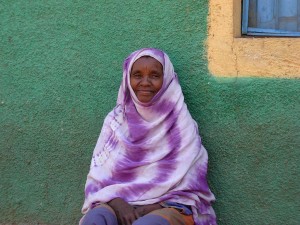
Women manage family health in Ethiopia.
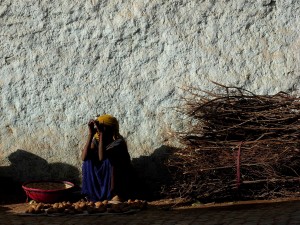
Pics by M. Sayagues
Ranging from sassy dialogue to black humour, these are one-minute comedies with a smart punchline. The Mother from Hell and the Spoiled Brat skits have [...]]]>

Make safe sex fun. By M. Sayagues
Ranging from sassy dialogue to black humour, these are one-minute comedies with a smart punchline. The Mother from Hell and the Spoiled Brat skits have a Borat-like humour. And who would have thought a condom ad from India would depict anal sex?
Click on the ad from Argentina even if you don’t speak Spanish. Everybody who has been a teenager will chuckle about these teens, their parents and their predicament. (Watch it here)
Laughing got me thinking about how seldom one sees humorous ads about condoms in English-speaking Southern Africa. I have seen some cool ads in Mozambique, though – I think there were Brazilian advisors involved. Where is the fun?
Most ads about condoms in Southern Africa are earnest, even boring, stressing safe sex, HIV prevention, responsibility. Few treat sex as an activity filled with desire, romance, anticipation, indecision, ambiguity, and pleasure.
Yes, for man, sex may be forced, violent, unwanted, unpleasant, too quick, too slow, or too risky.
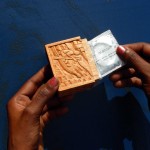
A pretty condom carrying box. By M. Sayagues
But for many others, it is not. Ads should target different segments. If we want to attract the attention of the young instead of totally turning them off, ads must be cool.
It is a fine balancing act. About three years ago, the South African anti-AIDS campaign LoveLife published a monthly insert in major newspapers, called Uncut that tried so hard to be blasé it was borderline pornographic.
There is a distance from acknowledging that young people have sex to portraying teens dressed like hookers in positions suggesting group oral sex. Many parents threw Uncut straight away. My daughter, aged 14 then and no prude, thought it cheapened girls.
After many complaints and public debate, Uncut changed. It went overboard. Now it reads like a church teen newsletter, wholesome and boring.
It may be that the terrifying scale of the AIDS pandemic in Southern Africa inhibits ad campaign planners and donors from portraying safe sex as fun. Maybe it is fear of offending churches, politicians and parents. And talking about sex has traditionally been taboo.
Yet, to get young people to practice safe sex, condoms must become part of their sexual paraphernalia and discourse. A bit of humour helps.
So have a laugh and tell us which is your favourite!
Ad selection courtesy of Chris Well, a designer and sexual rights activist at Conversations for a Better World. Check out his website for teens and reproductive health: www.15andcounting
Have you seen the Italian documentary Il corpo delle donne (available with English subtitles)?
It is horrifying, like a horror movie.
“Women –real women— are an endangered species on television, one that is being replaced by a grotesque, vulgar and humiliating representation,” says an introduction to the documentary [...]]]>
Have you seen the Italian documentary Il corpo delle donne (available with English subtitles)?
It is horrifying, like a horror movie.
“Women –real women— are an endangered species on television, one that is being replaced by a grotesque, vulgar and humiliating representation,” says an introduction to the documentary by Lorella Zanardo.
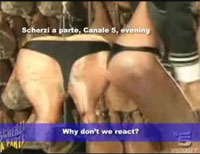
This picture shows a woman hanged from the ceiling, like a ham, surrounded by legs of ham. This and other images, taken from real TV shows, speak for themselves.
Il corpo delle donne is a 25-minute terrifying documentary that undresses the degradation of women in Italian television.
“This led us to select television images that share a common manipulative exploitation of the woman’s body, to let people know what is happening –not only people who never watch television, but especially those who watch it but ‘don’t see’,” says the introduction.
Why aren’t women, and men, rallying against this treatment?
Link with Il Corpo delle Donne in Facebook.
]]>I was very pregnant and very happy. I lived in Rome, Italy, and I wanted a home birth.
I wanted music, soft light, friends, baby on my [...]]]>

Safe motherhood for all. By F. Beaumont.
My daughter Esmeralda turns 18 today. Like all parents, I am amazed at how time flies. Like all mothers, I get reminiscent about those days, 18 years ago.
I was very pregnant and very happy. I lived in Rome, Italy, and I wanted a home birth.
I wanted music, soft light, friends, baby on my stomach still attached by umbilical cord, no drugs, and no epidural. A birth by my own rules, not by a cold hospital’s.
I found a group specialized in home births – Il Melograno. Their package included ob-gyn and midwife, courses, support and, more importantly, a woman-friendly feel. A photographer from Marie Claire magazine would do a photo reportage on my happy home birth.
Our premise: pregnancy is neither a disease nor a disability. Pregnancy and birth have become over-medicalized; women should reclaim it from doctors overly fond of control and caesareans. My family, my colleagues and the baby’s father thought I was crazy. Home births are more common now but women still battle to extricate pregnancy and birth out of the hospital realm.
In Brazil, we recently lost a battle for a centre for natural birth in Rio de Janeiro.
Clueless mommy
In my case, at midnight, after 30 hours of labour, I was stuck at 6 cms dilatation – and exhausted. A home birth must be 100 percent natural, so the few drops of oxitocyn to trigger full dilation had to be administered in hospital, three blocks away. There I went. At 2am my daughter was born – and promptly taken away to the nursery.
At 5:30am a nurse literally dumped my baby girl in my arms and left. No instructions on how to feed, nothing. My midwife and friends were coming at 8 am. What to do? I had never been around a newborn. I was like Carrie Bradshaw in Season 2 of Sex and The City – domesticity and motherhood were not part of my landscape.
So there I was, baby on one hand, baby book on the other, trying to figure it out. This is the most ridiculous and pathetic image of modern motherhood, I thought. How did we end here, from birth as a group event to 6 AM loneliness in hospital?
Less than 24 hours later, against hospital rules, I signed waivers absolving doctors of any responsibility and checked myself out.
I went home and turned on the CD player. My daughter’s godmother had been listening to the Rolling Stones: “You can’t always get what you want”. I chuckled.
Two close friends, one in Windhoek and one in London, recently tried a home birth but ended in hospital, just like me. Still, we were happy to go through labour at home.
Meanwhile, many women struggle to have a safe birth – anywhere. About half a million women die in childbirth very year. There are not enough trained midwives to ensure a safe labour, whether at home or at a clinic,

Art by Nelly Romeo Alves, photo by E. Zimbres
At a conference on reproductive health in Berlin last week, the World Health Organisation reported that one woman dies every minute for lack of adequate pregnancy and birth services.
A cruel paradox: the world proffers to revere motherhood but does not make it safe and comfortable for mothers to give birth.
]]>Some of those championing Caster Semenya’s cause accuse those wanting to sex-test Caster of imperialism and racism (as well as sexism). Others plead to wait before reaching a verdict, arguing that the realities of sex testing are enormously complex
Firstly to address the issue of terminology, over which [...]]]>
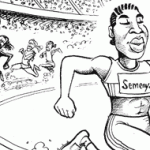
Courtesy of Zapiro, Mail & Guardian
Some of those championing Caster Semenya’s cause accuse those wanting to sex-test Caster of imperialism and racism (as well as sexism). Others plead to wait before reaching a verdict, arguing that the realities of sex testing are enormously complex
Firstly to address the issue of terminology, over which there seems to be confusion. Gender is the dominant society’s views on how women and men should look, behave, what roles they should play in society, how they should perform and frequently what rewards they receive – hence gender inequity. This has usually led to lower status and discrimination against girls/women but has increasingly been seen as limiting the options and potentially harming boys/men too.
Gender is not a politically correct term for sex. Sex testing would be just that – establishing whether a person is biologically female or male. So gender testing is not the term that should be used this case, but sex testing.
Secondly, to tackle the science issue, as this tends to obscure the real issue of gender stereotyping and discrimination so evident in this case. Professor Tim Noakes, an international sports science expert says the issue of ‘unfair advantage’ which is the only thing that should be at play here as it is in the case of drug use,is simple to establish.
He states that the issue that needs to be clarified here is whether the person concerned is a man masquerading as a woman or not. This could be established by a simple physical examination “handled within the usual constraints of the doctor/patient domain – not in the public domain” as has happened in the harmful manner in which the IAAF has handled this.
As for the rest, he says, there is great variation. All other possible tests including chromosome testing is indeterminate and so that should be left well alone. The calls for more to be done in dealing with
this issue and await judgment are therefore erroneous and cloud the issue in a shroud of inappropriate so-called scientific enquiry.
Sissies and butch
The third issue relates to what lies at the heart of the matter, social norms. While issues of racism and imperialism have and will continue to apply in various circumstances and have a sensitive history in terms of
women’s bodies, particularly in Africa, focusing on these issues in the current context obscures the much neglected ‘elephant in the room’ - gender discrimination. Comments within the press and on talk shows are
unwittingly guilty of this same problem in placing ‘blame’ at Athletics South Africa or her coach’s door.
They argue that the authorities should have pre-empted this situation, given her prior experiences (at the hands of the teachers, members of the public and previous authorities). ‘Pre-empting the situation’ would fall prey to the exactly these same prejudices – pandering to what people perceive to be ‘normal’ for girls or women.
This is akin to what might have happened during the apartheid era where actions may have tried to stave off racism by negotiating black people’s entry into racially reserved sporting or cultural events before the
time.
Many white girls who do not ‘look’ as society expects will tell similar humiliating stories of being stopped from entering female public toilets or being questioned as to whether they male or female.
At the core of this issue are ideas about gender – how girls/women and boys/men look and behave and perform (in this case perhaps a young woman winning by 2 seconds ahead of the field is not seen as ‘normal’).
This is what has been so hard to address locally in South Africa, despite our progressive constitution, due to deeply held dominant ideas about what is ‘female’ and ‘male’. It is these ideas and actions that promote gender discrimination. This leads to men, who in societies’ terms do not look ‘masculine enough’, being called ‘sissies’ and women who look not ‘feminine enough’ being labelled ‘butch’.
At the root, gender discrimination
In our own society, this has led to violent attacks on some women and in our own and other countries to violent attacks on some boys/men. This is what we need to clearly point as underlying this case and name it for what it is. Framing the discrimination as racism or imperialism without reference to gender discrimination as the main issue risks reinforcing gender stereotypes.
Societies have a long way to go in terms of changing the dominant ideas on how women and men should look and behave and perform, and in some cases, dress – and allow for variations in ‘looks’ and roles to be
underpinned by what people would like to be and do, rather than societies’ current dominant expectations.
There are many excellent organisations in our own country and abroad that have worked with women and men on this issues, but as it is all to obvious from this and other cases, much work is still needed for these choices and this freedom to take root in the broader society as a whole.

Supporters at the airport. Photo: Marion Stevens
Caster should not be having to deal with a world controversy over her win. She should be unreservedly basking in the glory of her and our incredible victory. No doubt she has experienced this humiliation and discrimination at other levels before and has become somewhat hardened to its effect, but we wish her, her friends and her family strength in dealing with this blatant gender discrimination.
As Caster Semenya and our other gold medal winner, Mbulaeni Mulaudzi, return home – congratulations on your amazing wins and Caster, you have our ful lsupport. For the rest, to Caster’s detractors or apologists, hang your heads in shame for not ‘naming’ the issue for what it is and for perpetuating gender stereotypes and discrimination in her individual case and in society as a whole.’
As we once again approach the 16 days of activism against violence against women, let us bear these issues in mind and not mouth platitudes in our struggle against gender inequity and discrimination.
Diane Cooper – Director, Women’s Health Research Unit, School of Public
Health and Family Medicine, University of Cape Town
Leslie London, Director, School of Public Health and Family Medicine,
University of Cape Town
Nomfundo Eland , Treatment Action Campaign (TAC) Women’s Rights Campaign
Larissa Klazinga and Rhodes Gender Action Project
Lisa Vetten, Tshwaranang Legal Advocacy Centre to End Violence Against Women
Nomfundo Eland, TAC Women’s Rights Campaign
Shirley Walters, University of Western Cape, South Africa
Lillian Artz, Director, Gender, Health and Justice Unit, University of Cape Town, South Africa
Glenn de Swardt, Health4Men
Jane Harries, Associate Director, Women’s Health Research Unit,
University of Cape Town
Jennifer Moodley, Women’s Health Research Unit, University of Cape Town
Sheila Meintjes, Political Studies Department, Wits University
Ilse Ahrends, the Saartjie Baartman Centre for Women and Children
Phumi Mtetwa,the Lesbian and Gay Equality Project
Marion Stevens, Health Systems Trust
Sipho Mthathi, Human Rights Watch South Africa.
Deborah Byrne, Foundation for Human Rights (FHR)
Sumaya Mall, Women’s Health Research Unit, University of Cape Town
Ntobeko Nywagi, Women’s Health Research Unit, University of Cape Town
Sheila Cishe, Women’s Health Research Unit, University of Cape Town
Chelsea Morroni, Women’s Health Research Unit, University of Cape Town
Phyllis Orner, Women’s Health Research Unit, University of Cape Town
Regina Mlobeli, Women’s Health Research Unit, University of Cape Town
Mary Jansen (KIWIA) Khoe San Indigenous Women in Action
Angelica Pino, Gender-based Violence Programme, Centre for the Study of
Violence and Reconciliation
Shireen Hassim, University of Witwatersrand, South Africa
Linda Cooper, Centre for Higher Education and Development, University
of Cape Town
Akosua Adomako Ampofo, Inst. of African Studies and Head, Centre for
Gender Studies & Advocacy, University of Ghana, Legon
Cathy Mathews, Medical Research Council
Fareeda Jadwat, African Gender Institute, University of Cape Town
Ilse Ahrends,Saartjie Baartman Centre for Women and Children, South
Africa
Di McIntyre, NRF chair, Health Economics Unit, University of Cape Town
Andrea Rother, Centre for Occupational and Environmental Health
Research, University of Cape Town
Carol Thomas, thewomanspace
Johanna Kehler, Director, AIDS Legal Network, South Africa
Carrie Shelver, People Opposing Women Abuse, South Africa
Gabi Jiyane, the Lesbian and Gay Equality Project
Balise Mahlangu, the Lesbian and Gay Equality Project
Ayanda Rapita, the Lesbian and Gay Equality Project
Gertrude Fester, Feminist Forum/ Women’s and Gender Studies,University
of Western Cape
Naeemah Abrahams, Gender and Health Research Unit, Medical Research
Council, South Africa
Angelica Pino, Gender-based Violence Programme, Centre for the Study of
Violence and Reconciliation, South Africa
Pamela Scully, Women’s Studies and African Studies, Emory University &
Deputy Editor, Women’s History Review
Mary Jansen (KIWIA) Khoe San Indigenous Women in Action
Melissa Steyn, Department of Sociology, University of Cape Town, South
Africa
Gabi Jiyane,the Lesbian and Gay Equality Project
Marion Heap, Health and Human Rights, School of Public Health and
Family Medicine,University of Cape Town
Balise Mahlanguthe, Lesbian and Gay Equality Project
Bernadette Bredekamp, Division of Family Medicine, University of Cape
Town
Ayanda Rapita, the Lesbian and Gay Equality Project
Larissa Klazinga and Rhodes Gender Action Project
Laura Pollecutt, South Africa
Sokari Ekine,London
Natasha Primo
Alex Kent
Annemarie Hendrikz
Jon Weinberg, Cape Town
Eva Hunt, South Africa
Shirley Gunn, Cape Town
Susan Holland-Muter, South Africa
Tara Weinberg, Cape Town Lavona George, South Africa
Gille de vlieg, South Africa
Michael Weinberg, Cape Town
Anne Schuster, South Africa
Jenny Radloff, South Africa
Kathy Watters, Cape Town
Sakina Mohamed, South Africa
Nicolene McLean, Gender Action Project
Carla Tsampiras, Rhodes History Dept
Corinne Knowles, GENACT
Alan Kirkaldy, NTESU
Thava Govender, Human Development Consulting Agency,KZN, South Africa
Richard Matzopoulos, Medical Research Council and UCT Public Health
Bernedette Muthien, Engender
Sally Gross,Intersex South Africa
Surplus People Project, South Africa
Sharon Stanton, S.L Stanton Attorneys
Tessa Lewin, Communications Manager, Pathways of Women’s Empowerment,
Institute of Development Studies, UK
Nisaa Institute for Women’s Development
So what headlines have grabbed you lately about male circumcision in South Africa? These caught my eye:
“The death toll in the Eastern Cape’s winter circumcision season has risen to 31”
“Circumcision ‘scam’ probed”
“Two [...]]]>
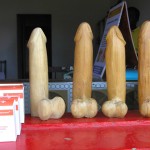
Hard task: defining sexual pleasure. Photo: M. Sayagues
So what headlines have grabbed you lately about male circumcision in South Africa? These caught my eye:
“The death toll in the Eastern Cape’s winter circumcision season has risen to 31”
“Circumcision ‘scam’ probed”
“Two on run after initiate dies”
As alarming and distressing as these headlines are – and the sad, desperate and greedy subtexts embedded in them – they don’t say much about the other big debate that is raging across southern Africa: the value of male circumcision to prevent HIV acquisition in heterosexual men, and what’s in it for women.
Well what’s in it for women is the topic du jour: Since observational studies had reported an association between male circumcision and reduced risk of HIV infection in female sexual partners, researchers in Uganda conducted an unblinded, randomised control trial to investigate this (Lancet July 2009) by circumcising some HIV positive men and not others. They found that circumcision did not reduce the risk of transmission to their female partners. So no luck there.
But what’s really getting gender activists of all genders to rise up from their sofas and comment on websites and chat rooms is the matter of sexual pleasure, and more specifically, the sexual pleasure of women.
What is sexual pleasure?
Now as a gay man I have to confess this is a topic that I have no personal experience of, but I am as interested in the notion of pleasure for my sisters of any sexual orientation as I am in mine.
I believe sexual pleasure should be a human right advanced to all, though for some of us this may be a progressive realisation of rights as we work through all the baggage of our socialisation!
I’m raising this issue because one of the many studies emerging as a companion to the now famous three circumcision trials, which showed the partial protective efficacy of male circumcision, suggests that “women whose male sexual partners were circumcised report an improvement in their sex life.”
Nearly 40% said sex was more satisfying afterward. About 57% reported no change in sexual satisfaction, and only 3% said sex was less satisfying after their partner was circumcised.
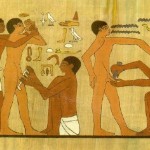
Ancient Egyptians get the snip.
Top reasons cited by women for their better sex life: improved hygiene, longer time for their partner to achieve orgasm, and their partner wanting more frequent sex, said Godfrey Kigozi at the Fifth International AIDS Society Conference on Pathogenesis, Treatment and Prevention of HIV in Cape Town recently.
Firstly, if you look at the data above, while 40% did say the sex was more satisfying, the majority in fact said there was either no change or it was less satisfying. Is the headline summary of the research accurate? Why do we need to spin this data?
Fluid and enigmatic
But really what’s vexed me, and others, is this notion of pleasure and how we define it. Those of us who come from a “social” as opposed to “biomedical” or “public health” paradigm would argue that sexuality is fluid, it changes over our lifetimes, it may be context or relationship dependent, it is informed not only by our gender but our class and orientation.
So “pleasure” in a sexual encounter may be shaped by mood, the time of life, the way a woman is relating to her partner that day, whether she was exhausted from chores, her beliefs about female agency in a sexual encounter, whether she was menstruating or in menopause, whether foreplay had occurred.
Pleasure, surely, is variable, contextual, dynamic, changing, unpredictable. Even enigmatic sometimes: a woman may have a good orgasm but still feel angry with her husband or partner. She may never have had an orgasm but feel happy that he does. She may secretly masturbate after he falls asleep and feel fantastic after that.
A biomedical or public health perspective, I would argue, reduces men and women and their practice to simple categories and distinct binaries: gay vs straight; masculine vs feminine; satisfied vs unsatisfied; safe vs dangerous.
This is necessary if you want a simplified view of the world and if you want “proof” that most women will be happy to have their male partners circumcised.
Who needs long and complicated qualitative research when a checklist with a choice of three options tells us all we need to know to placate those pesky social scientists with their doubts and ifs, buts and maybes? But how do you capture the nuances of satisfaction in a questionnaire?
You don’t. I think pleasure is much more complicated than that – and we need better and more interesting research to tease it out (as it were). What do you think?
Read more on controversial issues around male circumcision, sexual pleasure, human rights, viagra and condoms.
]]>